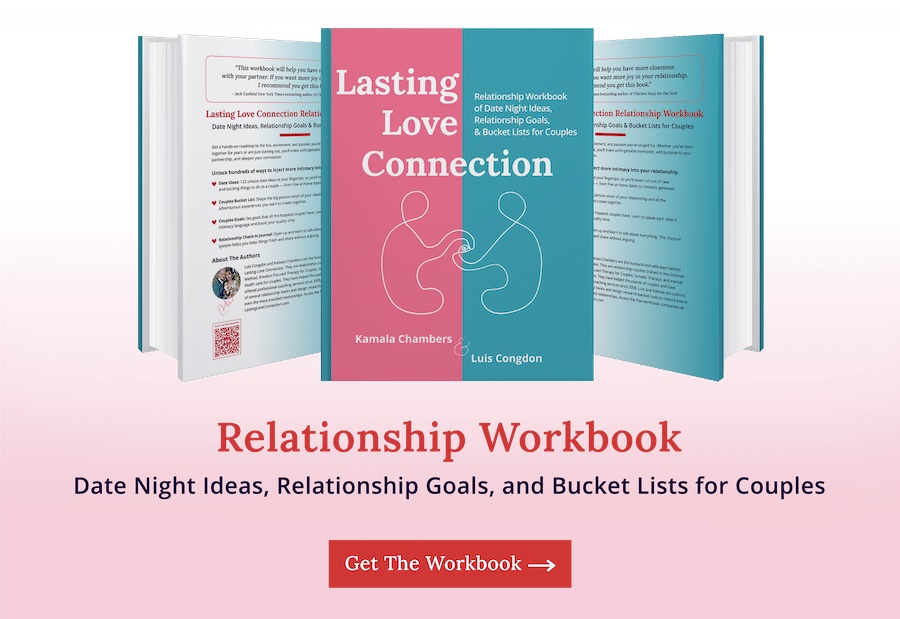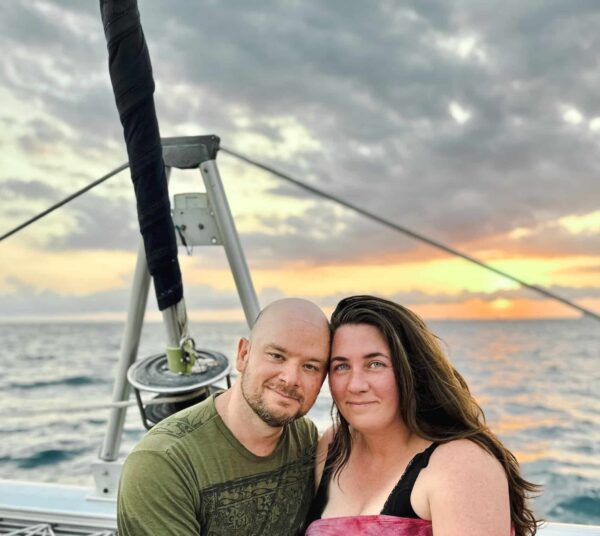Are you looking for an exercise for couples communication to strengthen your relationship?
Effective communication is the foundation of successful relationships, but it can be challenging to develop these skills.
Whether you’re facing communication problems or want to build a closer connection with your partner, this article offers exercises to reduce conflict, increase understanding, and deepen intimacy.
Table of Contents
What are the benefits of couples communication exercises?

First, let’s look at how communication exercises for couples enhance your relationship.
Build new communication patterns
Couples communication exercises disrupt unhealthy communication patterns.
Many couples get stuck in cycles of criticism, blame, and defensiveness, which drive conflict and disconnection.
These exercises give you tools to communicate effectively so you both feel heard and understood.
Using these skills, you’ll build new communication patterns that reduce conflict and increase connection.
Deepen understanding
Couples communication exercises give you a better understanding of each other’s thoughts, feelings, and perspectives.
These exercises encourage meaningful conversations that help you to discover more about each other and empathize with each other’s experiences.
Developing mutual understanding increases emotional intimacy, leading to a deeper connection.
Improve conflict resolution
Additionally, engaging in couples communication exercises sharpens your problem-solving skills.
The therapy techniques you will learn through these exercises will help resolve conflicts more smoothly and effectively.
10 communication exercises for couples
Let’s explore 10 effective couples therapy exercises to improve communication and strengthen your relationship.
Exercise for couples communication #1: Active listening

Active listening is essential for healthy communication in a relationship.
However, many couples struggle to truly listen to each other, often interrupting or talking over each other to get their point across.
This exercise gives each of you the chance to express yourselves without interruption.
Set a timer for 3-5 minutes and have one partner share whatever is on their mind – whether it’s work stress, concerns about friends or family, or anything else.
The silent partner should practice active listening by maintaining eye contact and open body language while refraining from speaking.
Then, the listener can repeat back what they heard and ask questions after the time is up to clarify and ensure understanding.
Then, switch roles so the other partner has an opportunity to share.
Exercise for couples communication #2: “I” statements
Using “I” statements is one of the most effective communication exercises for a loving, healthy relationship.
When you address your partner using “You always…” or “You never…”, they are likely to feel attacked and become defensive.
Instead, use an “I” statement to express your feelings and needs without criticizing or blaming your partner.
For example, instead of saying, “You never want to spend time with me anymore,” you can say, “I feel sad that we haven’t spent as much one-on-one time together lately. Can we schedule a date night soon?”
Expressing feelings through “I” statements makes it much more likely that your partner will be open to hearing your concerns.
Exercise for couples communication #3: Eye gazing

Eye gazing is a non-verbal exercise that allows you to connect on a deeper level without using words.
Multiple studies have discovered the benefits of eye-to-eye connection in deepening intimacy and trust.
To practice eye gazing, sit facing each other and look deeply into each other’s eyes.
Initially, this exercise may feel awkward, but try to refrain from talking or breaking the gaze.
Aim to maintain eye contact for five minutes.
After the exercise, talk about how you felt during the experience and what nonverbal cues you picked up from each other.
Exercise for couples communication #4: 40-20-40
The 40-20-40 exercise offers a clear structure for talking about relationship problems so you both feel heard.
During the exercise, each partner gets 40% of the conversation to express their feelings and perspectives without interruption.
The remaining 20% of the conversation is for working together to solve the issue.
Exercise for couples communication #5: Three and three

Three and Three is a simple and effective communication tool for couples.
All you need is a piece of paper and a pen.
Sit separately and write down three things you love about your relationship and three things you struggle with.
Instead of criticizing your partner and saying, “You never touch me,” reframe the statement using more positive language, like, “I would like more physical affection in our relationship.”
Share your lists and remain calm while discussing the things you don’t love and the steps you can take to improve your relationship.
Exercise for couples communication #6: Sandwich method
The “sandwich method” helps you to have a more constructive conversation about relationship problems.
This exercise involves ‘sandwiching’ constructive feedback between two positive statements.
After sharing your feedback, listen to your partner’s perspective and feelings.
Finally, end the conversation with positivity and appreciation for your partner’s strengths.
For example, you might tell your partner, “I appreciate all you do to help around the house. I sometimes feel frustrated when you don’t do the dishes like we agreed. I’m grateful that you did some of the dishes. Would you be willing to finish the dishes you stated?”
Exercise for couples communication #7: Stress-reducing conversation

Created by Dr. John Gottman, the stress-reducing conversation helps you alleviate stress through compassionate listening and mutual support.
Start by having one partner share their current concerns or stressors, no matter what they may be.
As your partner speaks, listen attentively.
Avoid the urge to jump in and offer advice or solutions.
Instead, validate your partner’s feelings by saying, “I could see how that would be really difficult.”
Then, switch roles; it’s the other partner’s turn to share their stressors.
Exercise for couples communication #8: Express gratitude
A gratitude exercise encourages partners to reflect on the positives in their relationship rather than focusing on the negatives.
Expressing gratitude sparks positive feelings in a relationship, enhancing your emotional connection and trust.
Gratitude exercises to try
- Tell your partner what you appreciate about them.
- Share three things you love about your relationship.
- Plan a date night your partner will enjoy.
- Thank their partner for their contributions.
Infuse more gratitude into your relationship with the Appreciation Game.
Exercise for couples communication #9: Discover your love languages

One of the most helpful communication exercises for couples is discovering each other’s love languages.
We all express and receive love differently.
Our preferred way to be loved is our ‘love language.’
Dr. Gary Chapman identified five love languages: words of affirmation, quality time, acts of service, gifts, and physical touch.
When we don’t speak our partner’s love language, it creates distance and frustration in the relationship.
For example, if you need words of affirmation to feel loved in a romantic relationship, but your partner shows love through physical touch, you’re likely to feel hurt and disconnected.
Helping your partner understand your love language gives them the insight they need to make you feel special and cared for, and vice versa.
Talking about what makes you feel loved allows you to show up for each other in the most meaningful ways.
Exercise for couples communication #10: Relationship check-ins
Relationship check-ins are a communication exercise that allows you to talk honestly about your relationship.
Through regular check-ins, you can address minor concerns before they escalate into bigger problems.
Make a concerted effort to set aside time each week to discuss what’s working well in your relationship and what you would like to be different.
Use these questions to guide relationship check-ins
- What were the highs and lows of your week?
- Are there any unresolved conflicts or issues we need to address?
- What did you appreciate about our relationship this week?
- Is there anything you feel was missing from our relationship this week?
- How can I support you in the week to come?
- Is there anything on your mind that you’d like to talk about?
For a step-by-step guide to relationship check-ins, pick up the Relationship Workbook.

Strengthen your communication skills in couples therapy
If trying communication exercises on your own hasn’t been successful, seek the support of a couples counselor.
Couples counseling offers a safe space to address communication issues and work towards establishing healthier communication patterns.
Book a complimentary couples consultation to learn more about our couples counseling services and determine whether working with us would be a good fit.
What does poor communication look like in a relationship?

Poor communication can manifest in a lack of active listening, patterns of criticism and defensiveness, and friction due to different communication styles. When communication is flooded with criticism, blaming, or defensive responses, it is challenging to address issues in a productive manner.
Why do couples lack communication?

Effective communication requires practice. Some romantic partners may not have learned healthy communication strategies or lack knowledge about communicating effectively. Growing up in environments without healthy relationships can influence how individuals communicate in their own relationships.
How do you deal with a partner that does not communicate?

Focus on your actions since you can’t change your partner’s behavior. Model active listening, openness, and willingness to discuss issues calmly and constructively. If communication difficulties persist and significantly affect your relationship, seek support from mental health professionals in person or virtually.
How to improve communication skills in a relationship?

Use these tips to strengthen your communication skills: 1.) Practice reflective listening. 2.) Use ‘I’ statements and express your own feelings instead of criticizing your partner’s behavior. 3.) Validate your partner’s feelings even when you disagree. 4.) Pay attention to your nonverbal cues. 5.) Seek relationship therapy if you need further support.






0 Comments